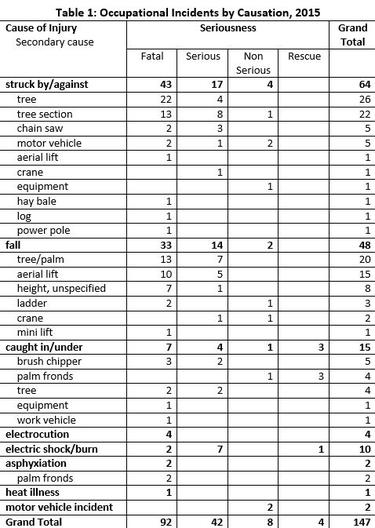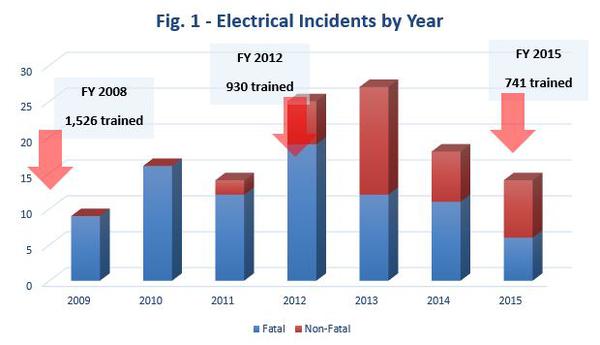Editor’s Note: This report was provided by Peter Gerstenberger, TCIA’s senior advisor for safety, standards and compliance.
The first reported tree care incident of 2015 occurred on January 11 in North Las Vegas. Daniel Wynn Smith was about 30 feet up in a palm tree, caught under a skirt of dead fronds and yelling for help. It took rescue crews about 15 minutes to reach the victim, whose position was completely obscured by hanging palm fronds. He was not showing any signs of life when he was retrieved by five units, including three special teams, from the North Las Vegas Fire Department.
 Rescuers were able to use a 100-foot ladder truck to extricate the man. This was the second time in a 30-day period that the NLV fire department responded to a person stuck in a palm tree. The previous incident on December 22 was less than a quarter of a mile away.
Rescuers were able to use a 100-foot ladder truck to extricate the man. This was the second time in a 30-day period that the NLV fire department responded to a person stuck in a palm tree. The previous incident on December 22 was less than a quarter of a mile away.
Mr. Smith was not a member of the Tree Care Industry Association (TCIA), and it is likely he was working alone at the time of the incident. He was 46.
Although there were only two palm fatalities in 2015, this incident typifies the incidents TCIA recorded for the year in several ways. In 2015, the average age of the accident victim was 43. Victims were typically out of the mainstream of the profession – not members of any organization, and likely not using educational programs or publications, nor attending trade shows or conferences.
In fact among all the cases where a company could be identified, only 17 percent were TCIA members and 83 percent were non-members.
As you can see from Table 1, there were 92 fatal tree care incidents in 2015, again pretty typical of recent years. In 2014 it was 81 and in 2013, 79.
While the overall number of incidents doesn’t seem to have changed appreciably year to year, there does seem to have been a downward trend in one statistic. Dr. John Ball remarked at TCI EXPO ’15 how, based upon his findings, the number of overall electrical incidents as well as the percentage of electrical incidents (as compared to other causes) had both declined in recent years.
Our accident database for 2015 seem to corroborate Dr. Ball’s findings. Electrical incidents comprise slightly less than seven percent of the total. Historically they hovered at around 25 to 30 percent of the total. This drop seems significant enough to beg the question, what is driving this change?
As a percentage of all fatal occupational incidents, electrical contact comprised 14 percent in 2011, 22 percent in 2012, 15 percent in 2013, 14 percent in 2014, and 7 percent in 2015. See Figure 1 below.

Who is having these incidents? For the past seven years (at least for the most part) it has not been the people you would suspect — the line clearance community. Rather, the incidents can be attributed to residential and/or commercial tree service companies and even landscaping crews who become de facto trimmers when the client asks. From the names of the companies involved as well as the descriptions of the incidents, TCIA determined that 67 percent of all electrical contacts were occurring on res/com crews while only 10 percent occurred on line clearance crews. Accounts of the remaining 23 percent did not provide enough information to make a determination.
Contrast that statistic from one derived from 106 OSHA-investigated fatal electrical contact incidents from 1984 through 2002, where 45 percent happened on utility line clearance crews. It seems clear that line clearance contractors as a whole are doing a better job of protecting their workers. Furthermore, there were an average of 5.6 incidents per year in that old data. Contrast that to Figure 1 above. It seems that while line clearance contractors became safer, the rest of the industry must have become much less so. What we don’t know from that time period is how many incidents occurred to one-person operations. With nobody and nothing left for OSHA to investigate, the incident never becomes part of the OSHA statistic.
In Figure 1, the red arrows and boxes showing a number trained indicate years in which TCIA undertook OSHA-sponsored electrical hazards training. It is tantalizing to consider that such broad-scale training may have actually suppressed the number of incidents, at least for a period of time. Of course, there are probably economic and even climatic factors that could have influenced the fluctuation in incidents.
Closing Thoughts
Since we opened with an accident representing the norm, it is fitting to close with an accident representing the exception. Usually the causes of these tragic incidents are painfully obvious. Every once in a while, the hazards in a particular situation do not readily present themselves.
The last incident of 2015 occurred on December 30.A 26-year-old tree trimmer fell 55 feet to his death while clearing storm-damaged limbs along some Pacific Gas & Electric lines near Weitchpec, north of Hoopa, California. The deceased was working for a TCIA member at the time, and we withhold the names of both employer and employee out of respect and because it is still an open case. Investigators from a number of entities are still working to figure out exactly what caused the fall.
Moving from average-to-good or good-to-great in hazard recognition and avoidance is mostly about vigilance. In a culture of safety, all employees are trained to recognize hazards and conditioned to be risk-averse, not only for themselves but for their fellow workers.
Don't Become a Statistic
TCIA offers safety workshops and certification programs designed to prevent the kind of incidents detailed in this report.
Arborists can enroll in the Certified Treecare Safety Professional program to become the go-to safety expert on the jobsite and enhance their careers. TCIA also facilitates workshops that specifically address electrical hazards, aerial lift/rescue operations, chipper operations, and other safety disciplines.
Click here to see a full list of upcoming TCIA workshops, many of which are offered at a low or reduced price courtesy of Tree Care Industry Association Foundation’s (TCIAF) Arborist Safety Training Institute (ASTI).